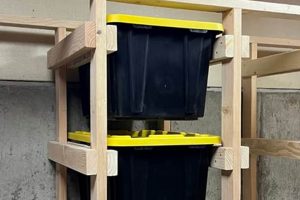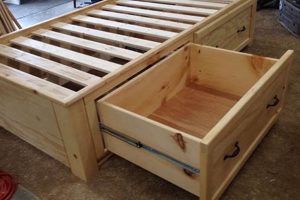A structure offering seating combined with an enclosed area for keeping items represents a dual-purpose furniture project. The project typically involves utilizing readily available materials and fundamental construction techniques to create a customized and functional piece. Examples range from simple wooden crates repurposed with a hinged lid to more elaborate designs featuring built-in drawers and cushioned tops.
The value of such projects lies in efficient space utilization, particularly in areas with limited square footage. Furthermore, constructing one provides opportunities for personalization, allowing individuals to match dcor and specific storage requirements. Historically, these have been employed in various cultures to maximize space in homes and public areas, demonstrating resourcefulness and adaptable design.
The following discussion will address the planning stages, materials selection, construction methodologies, and finishing techniques related to creating a durable and aesthetically pleasing seating and containment solution.
Construction Insights
These guidelines aim to ensure a successful and enduring outcome.
Tip 1: Material Selection: Opt for wood types appropriate for both structural integrity and environmental conditions. Pressure-treated lumber is recommended for outdoor applications, while hardwoods like oak or maple offer durability for indoor projects.
Tip 2: Accurate Measurements: Precise measurements are crucial for achieving a level and stable surface. Double-check all dimensions before cutting any materials to minimize errors and material waste.
Tip 3: Secure Fastening: Use appropriate screws or nails designed for woodworking. Pre-drilling pilot holes prevents splitting and ensures a stronger, more reliable joint.
Tip 4: Structural Reinforcement: Employ corner braces or gussets to strengthen joints, especially at stress points. This enhances stability and longevity.
Tip 5: Hinges and Support: Use heavy-duty hinges for lids to withstand repeated opening and closing. Implement support mechanisms, such as gas struts, for ease of use and safety.
Tip 6: Finishing Protection: Apply a sealant or paint appropriate for the chosen material and environment. This protects against moisture, UV damage, and wear.
Tip 7: Safety Considerations: Wear appropriate safety gear, including eye protection and gloves, when cutting, drilling, and sanding materials. Work in a well-ventilated area, especially when using adhesives or finishes.
Implementing these steps promotes a durable and functional final product.
The following sections will examine specific design considerations for varied applications.
1. Material Durability
Material durability is a fundamental consideration in the successful creation of seating and storage structures. The selection of robust materials directly influences the lifespan, functionality, and overall value of the finished piece. Failure to adequately address this aspect can result in premature deterioration, structural instability, and compromised utility.
- Resistance to Environmental Factors
Materials must withstand the intended environment of the structure. Outdoor applications necessitate resistance to moisture, UV radiation, and temperature fluctuations. Examples include the use of treated lumber to prevent rot or employing UV-resistant coatings to prevent fading and degradation of exposed surfaces. Inadequate resistance results in warping, cracking, and accelerated decomposition.
- Load-Bearing Capacity
The chosen material must possess sufficient strength to support the intended weight and stress. Softwoods, while often more affordable, may not be suitable for seating designed to accommodate significant loads. Hardwoods, such as oak or maple, provide superior strength and stability. Ignoring this requirement can lead to structural failure and potential injury.
- Abrasion and Impact Resistance
Surfaces subject to frequent contact or potential impacts require materials with inherent resistance to wear and tear. High-traffic areas benefit from durable finishes and impact-resistant materials to prevent scratches, dents, and other forms of cosmetic damage. Failure to consider this aspect leads to an aesthetically unappealing and rapidly deteriorating finished product.
- Resistance to Biological Degradation
Certain materials are susceptible to attack by insects, fungi, and other biological organisms. Untreated wood, in particular, can be vulnerable to termites and wood-boring beetles. Employing appropriate preservation techniques and selecting naturally resistant materials is crucial for long-term durability. Neglecting this factor can result in extensive structural damage and necessitate costly repairs.
The correlation between material durability and the overall success of seating and storage projects is undeniable. Careful selection and appropriate treatment of materials ensures a functional, safe, and aesthetically pleasing addition to any environment.
2. Structural Integrity
Structural integrity constitutes a non-negotiable attribute in the realm of seating and storage construction. It directly dictates the stability, load-bearing capacity, and overall safety of the final product. Inadequate attention to structural elements inevitably leads to compromised functionality and potential hazards. The very purpose of a is defeated if it cannot reliably support weight or withstand normal usage. A poorly constructed unit risks collapse, potentially causing injury and rendering the item unusable.
A practical example underscores the importance of robust construction. Consider a seating unit intended for outdoor use. If the frame lacks proper reinforcement and employs inadequate joinery, it will succumb to environmental stressors such as fluctuating temperatures and moisture exposure. Over time, the wood will warp, joints will weaken, and the entire structure will become unstable, rendering it unsafe and aesthetically unappealing. In contrast, a well-engineered incorporates reinforced corners, properly sized support beams, and weather-resistant fasteners, ensuring long-term durability and stability, even under adverse conditions.
The practical significance of comprehending structural requirements is paramount. Thorough planning, precise execution of joinery techniques, and the judicious selection of appropriate materials are essential for ensuring a safe and enduring outcome. Failure to prioritize structural integrity undermines the utility of the entire project. Thus, adherence to sound construction principles is not merely a suggestion but a fundamental necessity for the realization of a functional and reliable seating and storage solution.
3. Space Optimization
Effective space optimization represents a primary driver in the creation of seating with integrated storage. In residential settings characterized by limited square footage, the ability to combine seating and storage functions within a single furniture piece becomes acutely valuable. These constructions offer a practical solution for decluttering living areas, entryways, and bedrooms. The fundamental cause-and-effect relationship is clear: restricted space necessitates multi-functional furniture, and consequently, promotes efficient utilization of area. The absence of space optimization results in cluttered environments and underutilized potential. A narrow entryway, for example, benefits significantly from the inclusion of a unit to store shoes and provide a place to sit while putting them on, thereby maximizing functionality in a confined area.
Further applications encompass diverse settings. In classrooms, these designs provide seating alongside book or supply storage, minimizing clutter and promoting organization. Retail environments utilize similar concepts to offer customer seating while simultaneously storing inventory or promotional materials. The specific design adapts to the setting, but the underlying principle of maximizing available space remains constant. Furthermore, the capacity to customize these units provides a significant advantage. Dimensions can be tailored to precisely fit available spaces, and internal configurations can be adjusted to accommodate specific storage needs.
In conclusion, understanding the link between efficient space use and integrated seating and storage proves fundamental. These projects enable homeowners, businesses, and institutions to address the challenge of limited space through practical, adaptable, and visually cohesive solutions. While challenges may arise during design and construction, the overall impact on efficient space management remains substantial, highlighting the continued relevance and applicability of this approach.
4. Design Aesthetics
The integration of design aesthetics within the construction of seating and storage combinations transcends mere surface-level embellishment. It encompasses the holistic consideration of form, function, and material harmony, influencing the perceived value and long-term appeal of the finished project.
- Material Selection and Visual Harmony
The selection of materials directly impacts the visual character of the structure. The inherent grain patterns of wood, the texture of fabrics, and the sheen of metallic accents contribute to the overall aesthetic. Harmonious combinations of these elements create a cohesive visual experience. For instance, reclaimed wood paired with wrought iron hardware can evoke a rustic aesthetic, while smooth, painted surfaces and minimalist lines project a contemporary feel. Disharmonious material pairings can detract from the perceived quality and aesthetic appeal, regardless of the structural integrity.
- Proportion and Scale
The relative dimensions of the seating and storage unit must be proportionate to the surrounding environment. An oversized bench can overwhelm a small space, while an undersized one may appear insignificant and functionally limited. Scale extends beyond overall dimensions to include the size and placement of individual components, such as drawers, doors, and legs. Careful attention to proportion ensures visual balance and optimal integration within the intended setting. A well-proportioned structure complements the existing architectural features and enhances the overall spatial aesthetic.
- Color Palette and Finish
The choice of colors and finishes significantly influences the emotional response evoked by the seating and storage unit. Neutral tones create a sense of calm and versatility, while bold colors add vibrancy and personality. The finish, whether matte, gloss, or textured, affects the way light interacts with the surface, further shaping the visual perception. A thoughtfully selected color palette can complement existing dcor, create focal points, or visually expand a confined space. Conversely, an ill-chosen color scheme can clash with the surrounding environment and diminish the overall aesthetic appeal.
- Hardware and Embellishments
The selection of hardware, such as hinges, knobs, and pulls, presents an opportunity to enhance the visual character of the structure. These seemingly minor details can contribute significantly to the overall aesthetic. Simple, minimalist hardware can reinforce a contemporary design, while ornate, vintage-inspired hardware can complement a more traditional aesthetic. Similarly, decorative elements, such as carvings, moldings, and fabric accents, can add visual interest and personalize the structure. The strategic use of hardware and embellishments elevates the project beyond mere functionality, transforming it into a statement piece.
By carefully considering these facets of design aesthetics, the construction of a seating and storage unit transcends functional utility, resulting in a visually compelling and harmonious addition to any environment. The synthesis of form and function underscores the importance of a holistic approach to design, where aesthetic considerations are integrated from the outset, rather than treated as an afterthought.
5. Accessibility
The incorporation of accessibility considerations in the design and construction of seating with integrated storage is paramount, ensuring usability and inclusivity for individuals with varying physical capabilities. Failure to address these considerations can limit functionality and create barriers for specific user groups.
- Seat Height and Transfer Ease
The height of the seating surface directly impacts the ease with which individuals can transfer to and from the structure. A height that is too low requires excessive bending and exertion, posing challenges for those with limited mobility or joint pain. Conversely, a height that is too high can create a safety hazard. Standard accessible seating heights typically range from 17 to 19 inches, allowing for easier transfers from wheelchairs and reduced strain for individuals with mobility impairments. Adjusting height of a project should consider the end users.
- Storage Compartment Access
The design of storage compartments must accommodate a range of physical abilities. Deep, enclosed spaces can be difficult to reach for individuals with limited arm length or mobility. Drawers with full-extension glides provide complete access to the contents, while hinged lids with assistive mechanisms, such as gas struts, facilitate easy opening and closing. Placement of storage access points within a comfortable reach zone is essential for independent use.
- Clearance and Maneuvering Space
Adequate clearance around the seating and storage structure is necessary to accommodate wheelchairs, walkers, and other mobility aids. Sufficient maneuvering space allows individuals to approach, transfer to, and use the unit without obstruction. The Americans with Disabilities Act (ADA) provides specific guidelines for minimum clearance dimensions in accessible spaces. Incorporating these guidelines into the design process ensures that the structure is usable by a wider range of individuals.
- Operating Mechanisms and Hardware
The design and placement of operating mechanisms, such as latches, handles, and knobs, should prioritize ease of use for individuals with limited dexterity or grip strength. Lever-style handles are generally easier to operate than round knobs. Spring-loaded latches and magnetic closures require minimal force to open and close. Placement of these mechanisms within a comfortable reach zone ensures accessibility for individuals with varying physical abilities.
These facets underscore the importance of integrating accessibility principles throughout the design and construction of seating with integrated storage. By prioritizing inclusive design, these projects can serve a wider range of users and promote independence and usability for all.
Frequently Asked Questions
This section addresses common inquiries regarding the construction of seating incorporating integrated storage solutions, providing clear and concise answers to assist in planning and executing such projects.
Question 1: What is the optimal wood type for outdoor seating and storage?
Pressure-treated lumber or naturally rot-resistant species such as cedar, redwood, or teak are recommended for outdoor applications. These materials exhibit enhanced resistance to moisture, insect infestation, and decay, extending the lifespan of the structure.
Question 2: How can structural integrity be ensured in a large storage unit?
Reinforcement through the strategic placement of internal supports, corner braces, and properly sized fasteners is crucial. Employing joinery techniques such as mortise and tenon joints, or biscuit joints, further enhances structural stability.
Question 3: What is the recommended height for seating designed for universal accessibility?
A seat height ranging from 17 to 19 inches facilitates easier transfers for individuals with mobility impairments. This height aligns with accessibility standards and promotes greater ease of use for a wider range of users.
Question 4: How can moisture damage to stored items be prevented?
Proper ventilation within the storage compartment is essential. Implementing drainage solutions and using moisture-resistant liners further mitigates the risk of water damage to stored goods.
Question 5: What are the key considerations for designing a hinged lid with enhanced safety?
Utilizing heavy-duty hinges and incorporating soft-close mechanisms or gas struts prevents abrupt closure and minimizes the risk of injury. Proper alignment and secure fastening of hinges are also critical for safe operation.
Question 6: How can a cohesive aesthetic be achieved when combining seating and storage elements?
Selecting materials and finishes that complement the surrounding environment is paramount. Maintaining consistent design elements, such as hardware styles and color palettes, creates a unified and visually appealing structure.
In summary, careful material selection, robust construction techniques, and attention to accessibility and safety are critical factors in creating a functional and aesthetically pleasing seating and storage unit.
The following section will provide a summary of key considerations and future trends.
Conclusion
The exploration of “diy bench with storage” has revealed its multifaceted nature, extending beyond mere furniture construction. Considerations such as material durability, structural integrity, space optimization, design aesthetics, and accessibility each play a crucial role in the creation of a functional and enduring piece. Sound planning and execution, coupled with a thorough understanding of user needs, are essential for achieving a successful outcome.
As space constraints become increasingly prevalent, the demand for versatile, multi-functional furniture solutions will likely continue to rise. Individuals are encouraged to carefully assess their needs and available resources, prioritize structural integrity and safety, and to approach these projects with diligence. A thoughtfully constructed unit can provide years of service and contribute significantly to the functionality and aesthetic appeal of any environment.







![Build Your Own! Storage Bin Rack DIY Project [Easy] The DIY Hub: Creative Crafts, Repairs & Life Hacks Build Your Own! Storage Bin Rack DIY Project [Easy] | The DIY Hub: Creative Crafts, Repairs & Life Hacks](https://craftingdiycenter.com/wp-content/uploads/2025/07/th-1825-300x200.jpg)